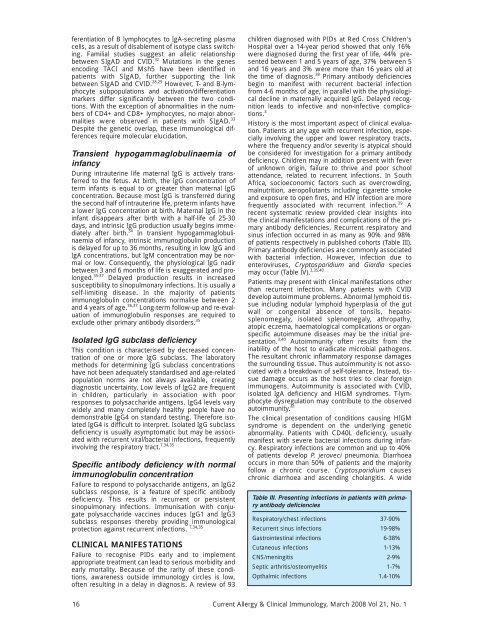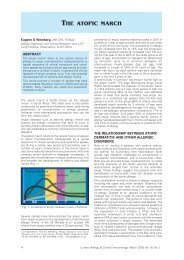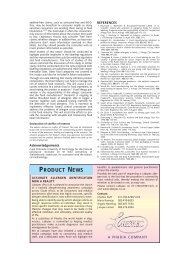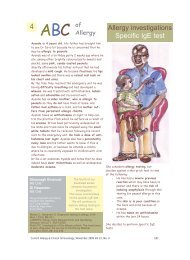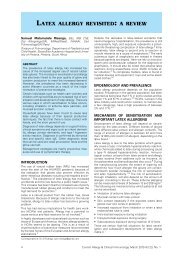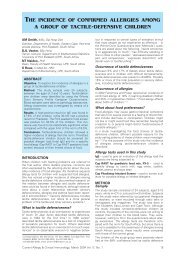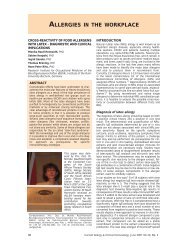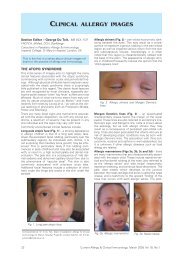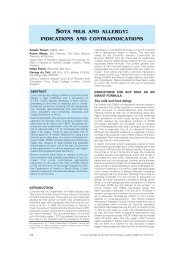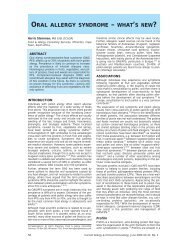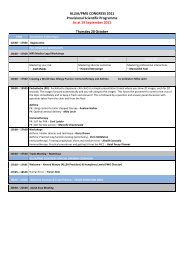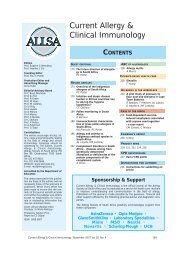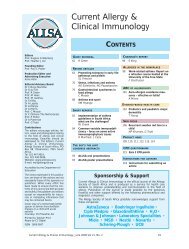Current Allergy and Clinical Immunology - March 2008
Current Allergy and Clinical Immunology - March 2008
Current Allergy and Clinical Immunology - March 2008
You also want an ePaper? Increase the reach of your titles
YUMPU automatically turns print PDFs into web optimized ePapers that Google loves.
ferentiation of B lymphocytes to IgA-secreting plasmacells, as a result of disablement of isotype class switching.Familial studies suggest an allelic relationshipbetween SIgAD <strong>and</strong> CVID. 32 Mutations in the genesencoding TACI <strong>and</strong> Msh5 have been identified inpatients with SIgAD, further supporting the linkbetween SIgAD <strong>and</strong> CVID. 28,29 However, T- <strong>and</strong> B-lymphocytesubpopulations <strong>and</strong> activation/differentiationmarkers differ significantly between the two conditions.With the exception of abnormalities in the numbersof CD4+ <strong>and</strong> CD8+ lymphocytes, no major abnormalitieswere observed in patients with SIgAD. 33Despite the genetic overlap, these immunological differencesrequire molecular elucidation.Transient hypogammaglobulinaemia ofinfancyDuring intrauterine life maternal IgG is actively transferredto the fetus. At birth, the IgG concentration ofterm infants is equal to or greater than maternal IgGconcentration. Because most IgG is transferred duringthe second half of intrauterine life, preterm infants havea lower IgG concentration at birth. Maternal IgG in theinfant disappears after birth with a half-life of 25-30days, <strong>and</strong> intrinsic IgG production usually begins immediatelyafter birth. 34 In transient hypogammaglobulinaemiaof infancy, intrinsic immunoglobulin productionis delayed for up to 36 months, resulting in low IgG <strong>and</strong>IgA concentrations, but IgM concentration may be normalor low. Consequently, the physiological IgG nadirbetween 3 <strong>and</strong> 6 months of life is exaggerated <strong>and</strong> prolonged.35-37 Delayed production results in increasedsusceptibility to sinopulmonary infections. It is usually aself-limiting disease. In the majority of patientsimmunoglobulin concentrations normalise between 2<strong>and</strong> 4 years of age. 36,37 Long-term follow-up <strong>and</strong> re-evaluationof immunoglobulin responses are required toexclude other primary antibody disorders. 35Isolated IgG subclass deficiencyThis condition is characterised by decreased concentrationof one or more IgG subclass. The laboratorymethods for determining IgG subclass concentrationshave not been adequately st<strong>and</strong>ardised <strong>and</strong> age-relatedpopulation norms are not always available, creatingdiagnostic uncertainty. Low levels of IgG2 are frequentin children, particularly in association with poorresponses to polysaccharide antigens. IgG4 levels varywidely <strong>and</strong> many completely healthy people have nodemonstrable IgG4 on st<strong>and</strong>ard testing. Therefore isolatedIgG4 is difficult to interpret. Isolated IgG subclassdeficiency is usually asymptomatic but may be associatedwith recurrent viral/bacterial infections, frequentlyinvolving the respiratory tract. 7,34,35Specific antibody deficiency with normalimmunoglobulin concentrationFailure to respond to polysaccharide antigens, an IgG2subclass response, is a feature of specific antibodydeficiency. This results in recurrent or persistentsinopulmonary infections. Immunisation with conjugatepolysaccharide vaccines induces IgG1 <strong>and</strong> IgG3subclass responses thereby providing immunologicalprotection against recurrent infections. 7,34,35CLINICAL MANIFESTATIONSFailure to recognise PIDs early <strong>and</strong> to implementappropriate treatment can lead to serious morbidity <strong>and</strong>early mortality. Because of the rarity of these conditions,awareness outside immunology circles is low,often resulting in a delay in diagnosis. A review of 93children diagnosed with PIDs at Red Cross Children'sHospital over a 14-year period showed that only 16%were diagnosed during the first year of life, 44% presentedbetween 1 <strong>and</strong> 5 years of age, 37% between 5<strong>and</strong> 16 years <strong>and</strong> 3% were more than 16 years old atthe time of diagnosis. 38 Primary antibody deficienciesbegin to manifest with recurrent bacterial infectionfrom 4-6 months of age, in parallel with the physiologicaldecline in maternally acquired IgG. Delayed recognitionleads to infective <strong>and</strong> non-infective complications.3History is the most important aspect of clinical evaluation.Patients at any age with recurrent infection, especiallyinvolving the upper <strong>and</strong> lower respiratory tracts,where the frequency <strong>and</strong>/or severity is atypical shouldbe considered for investigation for a primary antibodydeficiency. Children may in addition present with feverof unknown origin, failure to thrive <strong>and</strong> poor schoolattendance, related to recurrent infections. In SouthAfrica, socioeconomic factors such as overcrowding,malnutrition, aeropollutants including cigarette smoke<strong>and</strong> exposure to open fires, <strong>and</strong> HIV infection are morefrequently associated with recurrent infection. 39 Arecent systematic review provided clear insights intothe clinical manifestations <strong>and</strong> complications of the primaryantibody deficiencies. Recurrent respiratory <strong>and</strong>sinus infection occurred in as many as 90% <strong>and</strong> 98%of patients respectively in published cohorts (Table III).Primary antibody deficiencies are commonly associatedwith bacterial infection. However, infection due toenteroviruses, Cryptosporidium <strong>and</strong> Giardia speciesmay occur (Table IV). 3,35,40Patients may present with clinical manifestations otherthan recurrent infection. Many patients with CVIDdevelop autoimmune problems. Abnormal lymphoid tissueincluding nodular lymphoid hyperplasia of the gutwall or congenital absence of tonsils, hepatosplenomegaly,isolated splenomegaly, athropathy,atopic eczema, haematological complications or organspecificautoimmune diseases may be the initial presentation.3,40 Autoimmunity often results from theinability of the host to eradicate microbial pathogens.The resultant chronic inflammatory response damagesthe surrounding tissue. Thus autoimmunity is not associatedwith a breakdown of self-tolerance. Instead, tissuedamage occurs as the host tries to clear foreignimmunogens. Autoimmunity is associated with CVID,isolated IgA deficiency <strong>and</strong> HIGM syndromes. T-lymphocytedysregulation may contribute to the observedautoimmunity. 41The clinical presentation of conditions causing HIGMsyndrome is dependent on the underlying geneticabnormality. Patients with CD40L deficiency, usuallymanifest with severe bacterial infections during infancy.Respiratory infections are common <strong>and</strong> up to 40%of patients develop P. jeroveci pneumonia. Diarrhoeaoccurs in more than 50% of patients <strong>and</strong> the majorityfollow a chronic course. Cryptosporidium causeschronic diarrhoea <strong>and</strong> ascending cholangitis. A wideTable III. Presenting infections in patients with primaryantibody deficienciesRespiratory/chest infections 37-90%Recurrent sinus infections 19-98%Gastrointestinal infections 6-38%Cutaneous infections 1-13%CNS/meningitis 2-9%Septic arthritis/osteomyelitis 1-7%Opthalmic infections 1.4-10%16 <strong>Current</strong> <strong>Allergy</strong> & <strong>Clinical</strong> <strong>Immunology</strong>, <strong>March</strong> <strong>2008</strong> Vol 21, No. 1


